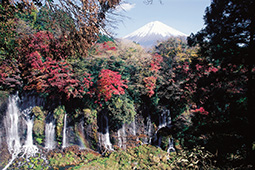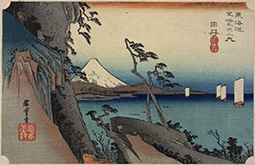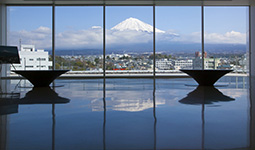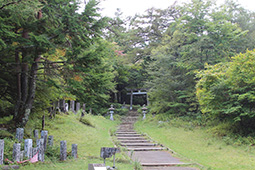January 2023
- English
- 日本語
Mt. Fuji: Sacred Place and Source of Artistic Inspiration

Inaba Nobuko, professor emeritus at the University of Tsukuba 
Fujisanhongu Sengentaisha Shrine in Fujinomiya City, Shizuoka Prefecture

View over the Shiraito no Taki waterfalls toward Mt. Fuji in Fujinomiya City, Shizuoka Prefecture 
A former oshi lodging house of the Togawa family in Fujiyoshida City, Yamanashi Prefecture 
Tokaido goju-san tsugi no uchi Yui Satta Mine (Yui: Satta Peak from the Fifty-Three Stations of the Tokaido Road) by Utagawa Hiroshige (Collection of the Tokyo National Museum) 
A Taisho-period (1912–1926) kimono with motifs of Mt. Fuji and Miho no Matsubara pine trees (see here) (Collection of the Tokyo National Museum) 
View from the Observation Hall at the Mt. Fuji World Heritage Centre, Fujinomiya City, Shizuoka Prefecture 
The umagaeshi to the Yoshida Ascending Route at the base of Mt. Fuji

In June 2013, Mt. Fuji (elevation: 3,776 meters) was inscribed on the World Heritage List under the title, “Fujisan, sacred place and source of artistic inspiration.” We spoke with Inaba Nobuko, professor emeritus at the University of Tsukuba and member of the Fujisan World Cultural Heritage Academic Committee, about the sacred mountain, the art inspired by it and its value as world heritage.

How did Mt. Fuji come to be a sacred place?
Mt. Fuji repeatedly erupted from the 8th century through the 9th century. People were afraid that this was an expression of anger from Asama-no-Okami, a mountain deity who could breathe fire. So, in time, a form of faith developed among the people as they worshiped Mt. Fuji from the foot of the mountain to appease the anger of Asama-no-Okami. It is said that shrines such as Fujisanhongu Sengentaisha* (Fujinomiya City, Shizuoka Prefecture) and Kawaguchi Asama-jinja (Fujikawaguchiko Town, Yamanashi Prefecture) were built at this time in their current locations to worship Asama-no-Okami.
As Mt. Fuji’s volcanic activity paused in the 11th century, a type of faith developed where people would ascend the mountain to worship. Mountain ascetics began to climb Mt. Fuji as a place of training for shugendo, which combines mountain worship with other religions such as Buddhism. Later, it became possible for ordinary people to climb the mountain to practice their faith, and trails up the mountain became well established, including the Subashiri Ascending Route and Yoshida Ascending Route.
Starting in the 17th century, the Fuji-ko faith, which was founded by Hasegawa Kakugyo (1541–1646) and whose practitioners worshipped Mt. Fuji, spread in the Kanto region. Practitioners of the faith would gather with others from their region and aim for the summit of Mt. Fuji after making group pilgrimages to sacred sites where Kakugyo trained, such as the Fuji Five Lakes (see here), Oshino Hakkai springs (see here), and Shiraito no Taki waterfalls**. At the starting points of the trails to the summit, people called oshi would offer lodging, food and prayers to practitioners, and would assist them in their preparations to climb the mountain.


The shrines, trails, lakes, ponds, waterfalls and oshi lodging houses I just mentioned are all component parts of Mt. Fuji’s World Heritage listing.
As a source of artistic inspiration, in what kinds of art work has Mt. Fuji been the subject?
Mt. Fuji has been the subject of a variety of art works, including poems, novels, plays, and paintings. The mountain has been used as a motif in many crafts such as lacquerware, porcelain and furniture, as well as kimono and other items. This is how familiar Mt. Fuji is to the Japanese people.
Paintings and handicrafts decorated with Mt. Fuji were exported, too. The ukiyo-e woodblock prints by Katsushika Hokusai (see here) and Utagawa Hiroshige (see here) were particularly famous. These woodblock prints had an influence on art overseas, particularly in Europe. For example, a number of woodblock prints appear in the background of Portrait of Père Tanguy by Vincent van Gogh (1853–1890), who was born in the Netherlands. Among these is a print thought to be modeled on Hiroshige’s Mt Fuji. French composer Claude Debussy (1862–1918) had a copy of Under the Wave off Kanagawa from Hokusai’s Thirty-six Views of Mount Fuji decorating his room. Per the composer’s request, a wave based on Under the Wave off Kanagawa was also depicted on the cover of the first edition of the score for Debussy’s “symphonic sketches” La Mer (The Sea). It is said that it was around this time that Mt. Fuji came to be established as a symbol of Japan outside the country.


What value does Mt. Fuji have as a world heritage site?
World Heritage sites are selected by the World Heritage Committee based on the Convention Concerning the Protection of the World Cultural and Natural Heritage that was adopted by the General Conference of UNESCO in 1972 to protect cultural and natural properties with outstanding universal value. There are different types of world heritage sites: cultural sites that include monuments, groups of buildings, historical sites, and landscapes; natural sites that include landforms, geology, and ecosystems; and mixed sites that have value as both culture and natural sites. Mt. Fuji is registered as a cultural site. It was inscribed as a cultural site because, as I’ve mentioned, while a part of nature it is also a presence that has had a major impact on culture not just in Japan, but around the world.
There are many mountains around the world that are either beautiful or have come to be sacred places just like Mt. Fuji. However, there are hardly any mountains in the world like Mt. Fuji that are beautiful, sacred, and a source of artistic inspiration.
In the past, the World Heritage Committee had separate selection criteria for natural sites and cultural sites. But this was revised in 2005, and the two criteria were combined. This was based on the idea that the presence of strong connections between people and nature, such as in parks, terraced rice paddies, and cultural landscapes, should also be recognized as having value when listing world heritage sites. Mt. Fuji has truly great global value as a model for world heritage sites in the boundaries between nature and culture.
What changes have occurred in the decade since Mt. Fuji became a world heritage site?
Since the late 1990s, the national government, local governments in Shizuoka and Yamanashi Prefectures, companies, and citizens worked together to start a movement towards getting Mt. Fuji inscribed as a world heritage site. Since then and continuing to today, there has been progress in the protection of the environment and landscapes of Mt. Fuji. For example, environmentally-friendly toilet facilities have been installed along the trails to the summit. Yamanashi Prefecture has also established regulations to protect Mt. Fuji’s landscapes, and construction of buildings in designated areas must now take into consideration the surrounding landscape. In addition, buildings in the area that were damaging to the landscape have been moved or rebuilt.
The challenge for the future is in how to maintain sustainable tourism to Mt. Fuji. Many tourists visit Mt. Fuji and the surrounding regions throughout the year. In particular, during a short period of time in summer, many people from within Japan and abroad gather to climb Mt. Fuji. An important challenge will be in figuring out how to control this. It is also important to convey the cultural value of Mt. Fuji to those who visit the mountain.
Can you recommend any places for an overseas visitor to experience the charm of Mt. Fuji?
There are many places where you can enjoy majestic scenery even if you don’t climb to the top of Mt. Fuji. To see the full view of Mt. Fuji, I think a good place to go would be Lake Motosu, which has been made famous through the photographs of Okada Koyo (see here). Mt. Fuji seen from the Observation Hall of the Mt. Fuji World Heritage Centre, Shizuoka in Fujinomiya City, Shizuoka Prefecture is also exquisite.

I also recommend walking the Yoshida Ascending Route from the umagaeshi located at 1,450 meters in elevation to the 5th station located 2,300 meters up. Umagaeshi means to “turn a horse around.” It is a spot where the trail gets rocky and you must return the horse you’ve been riding and continue on foot. The Yoshida Ascending Route is a historic path that was traversed by Fuji-ko practitioners, as well. It takes about three and a half hours to walk from the umagaeshi to the 5th station, and it feels wonderful to walk along the trail as it passes through the forest.

I hope that many people from within Japan and abroad can come to know Mt. Fuji’s history and culture, as well as its beauty.
- * See Highlighting Japan August 2019, “Mount Fuji, Object of Faith” https://www.gov-online.go.jp/eng/publicity/book/hlj/html/201908/201908_08_en.html
- ** Shiraito no Taki waterfalls are located in Fujinomiya, Shizuoka Prefecture. Water from the melted snow of Mt. Fuji flows and falls down a 20-meter-high, 150-meter-wide cliff.

